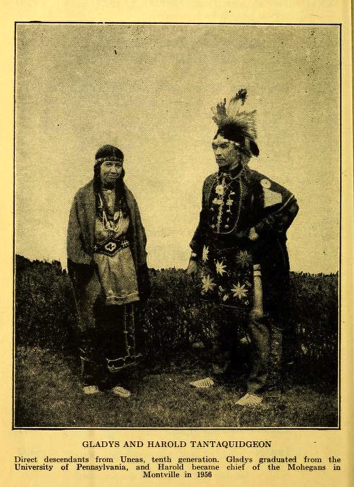“You shall always remain in [the land] where your [creator] is.”
—Fidelia Fielding
By Melissa Tantaquidgeon Zobel
Every nation has a spirit. The Mohegan Spirit moves and breathes within the very rocks and trees of the Mohegan Homeland in Uncasville, Connecticut. That sacred landscape has been crushed and trampled for four centuries by Non-Indian invaders who have denied the inherent spiritual value of that plot of earth.
To the Mohegans, land is the fabric upon which the designs of religious beliefs and patterns of history are colorfully woven. A map of the Mohegan Homeland is more than a setting for sacred stories and traditional tribal epics. It is a portrait of a spiritual landscape. The significance of this area derives from the Tribe’s continuous existence there under the watchful eye of Gunche Mundu, the Great Mystery and Creator of All Things.
One of the more sacred sites within this spiritual landscape is Moshup’s Rock. This site, negatively referenced by Christian missionaries as the “Devil’s Footprint,” is a rock embedded with the footprint of the giant named Moshup who roams New England. Gladys Tantaquidgeon explained that early Euro-Christians frequently lent the Devil’s name to people and places valued by Mohegans “in order to denigrate them.” While Indians taught that bad weather was caused by Moshup and Granny’s arguments, white missionaries changed that tale to suggest that bad weather was caused by the Devil (in the form of Moshup), whipping his wife (in the form of Granny Squannit). This depiction denigrated both Moshup and Granny Squannit. The latter is one of the Makiawisug or Little People, diminutive ancient beings who inhabit the shores of the ocean and rivers in southern New England.
Gladys Tantaquidgeon tells the following story of other footprints that link the traditional trails of Moshup in nearby Moodus, Uncasville, and Old Lyme, Connecticut, with those on Montauk, Long Island and on Martha’s Vineyard and Vineyard Sound, Massachusetts:
He [Moshup] was attempting to build a bridge from Gay Head, Martha’s Vineyard, to the mainland, known as Vineyard Sound. He was so large and powerful that he could pick up a large rock and throw it into the water. Someone interfered with his plans and he became so angry that his feet turned firey red and he left that area and stepped from where he lived on that island to the mainland and into parts of Connecticut. The stones where he stepped were called ‘Devil’s Footprints” …
Mohegan Medicine Woman and Tribal Historian Melissa Tantaquidgeon Zobel holds an MA in history from the University of Connecticut Connecticut and an MFA in Creative Writing from Fairfield University; she has authored several books, including Medicine Trail: The Life and Lessons of Gladys Tantaquidgeon (University of Arizona Press, 2000) and Oracles: A Novel (University of New Mexico Press, 2004).
This article is excerpted from her book The Lasting of the Mohegans, Part I: The Story of the Wolf People (Uncasville: The Mohegan Tribe, 1992), which won the inaugural First Book Award from the Native Writers’ Circle of the Americas.










